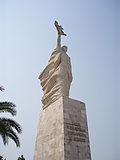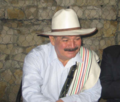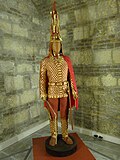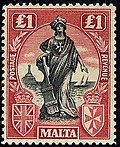National personification
Appearance

A national personification is an
.Examples of personifications of the
Roma, a female deity who personified the city of Rome and her dominion over the territories of the Roman Empire.[1] Roma was probably favoured by Rome's high-status Imperial representatives abroad, rather than the Roman populace at large. In Rome, the Emperor Hadrian built and dedicated a gigantic temple to her as Roma Aeterna ("Eternal Rome"), and to Venus Felix, ("Venus the Bringer of Good Fortune"), emphasising the sacred, universal and eternal nature of the empire.[2] Examples of representations of the everyman or citizenry in addition to the nation itself are Deutscher Michel, John Bull and Uncle Sam.[3]
cities of Italy. The origin of the turreted woman is linked to the figure of Cybele, a deity of fertility of Anatolian origin, in whose representations she wears a wall crown.[5] Its most classic aspect derives from the primordial myth of the Great Mediterranean Mother
.
Gallery
-
Iudaea Capta, "
-
Britannia arm-in-arm with Uncle Sam symbolizes the British-American alliance in World War I. The two animals, the Bald eagle and the Barbary lion, are also national personifications of the two countries.
-
In this Allegory depicting the 1576 Pacification of Ghent by Adriaen Pietersz van de Venne, the seated women represent a short-lived unity among the embattled provinces of what would become the present-day Belgium and Netherlands.
-
1909 cartoon in Puck shows (clockwise) US, Germany, Britain, France and Japan engaged in naval race in a "no limit" game.
-
Columbia depicted in anAmerican Committee for Relief in the Near Eastposter defending an Armenian woman beneath her flag
-
The Liberty of Oudiné in memory of the Argentine centenary of the May Revolution (1810-1910)
-
unified Italy
-
The winged Lion of Saint Mark at the Scuola Grande di San Marco, Venice. The open book holds the legend PAX TIBI MARCE EVANGELISTA MEVS (lit. 'Peace unto you, Mark, my Evangelist')
-
The Capitoline Wolf is a bronze sculpture depicting a scene from the legend of the founding of Rome. The sculpture shows a she-wolf suckling the mythical twin founders of Rome, Romulus and Remus.
-
Saint Michaelat right, gesturing to, from left: an unspecified figure, Brittania, Italia, Austria, Mother Russia, Germania, and Marianne of France
Personifications by country or territory
See also
- Afghanis-tan, a manga originally published as a webcomic about Central Asia with personified countries.
- online communities.
- Hetalia, a manga and anime about personified countries interacting.
- Mural crown
- National animal, often personifies a nation in cartoons.
- National emblem, for other metaphors for nations.
- National god, a deity that embodies a nation.
- National patron saint, a Saint that is regarded as the heavenly advocate of a nation.
References
- ^ "Il Tempio di Venere e Roma" (in Italian). Retrieved 12 September 2023.
- ISBN 3-11-010389-3.
- ^ Eric Hobsbawm, "Mass-Producing Traditions: Europe, 1870-1914," in Eric Hobsbawm and Terence Ranger, eds., The Invention of Tradition (Cambridge, 1983), 263-307.
- ISBN 978-88-96817-06-3.
- ISBN 978-88-96817-06-3.
- ^ White, Richard (2021). "The slippery symbols of Australia". State Library of New South Wales.
- ISBN 8176484695. Retrieved July 11, 2012.
- ^ "NATIONAL SYMBOLS". Bangladesh Tourism Board. Bangladesh: Ministry of Civil Aviation & Tourism. Archived from the original on 2016-12-28. Retrieved 2015-09-10.
- ISBN 978-2-930423-01-2.
- ISBN 978-1-909662-30-8.
- ^ "20th SEA Games 1999". 2001-03-02. Archived from the original on 2001-03-02. Retrieved 2024-06-20.
- ^ "Berita 2021c - Rekaan baju 'Dang Budiwati' imbau zaman gemilang Sukan SEA NBD". www.pelitabrunei.gov.bn. Retrieved 2024-06-20.
- ISBN 9780773551589. Retrieved 17 May 2019.
- ISBN 9780195427073.
- . Retrieved 2024-08-04.
- ^ "Library and Archives Canada". Library and Archives Canada.
- ^ "CHILE: 50 AÑOS DEL GOLPE. EL ÁNGEL DE LA LIBERTAD". Rascacielos. September 2023. Retrieved 15 June 2024.
- ^ "网民为什么会把中国称为"兔子"" [Why do Internet called China a "hare"?]. The Paper (in Chinese). 1 August 2015. Retrieved 8 October 2021.
- ^ "Animals in Cyprus". AZ Animals. Retrieved 2023-01-06.
- ^ Abdou, Mona. "Nahdet Misr: A Sculpture That Embodies Egypt At A Glance". Egyptian Streets. Retrieved 20 November 2021.
- ^ "Mahmoud Mukhtar: Egypt Awakened". University College London. Retrieved 10 April 2025.
- ^ Hassanabadi, Mahmoud. "Rostam: A Complex Puzzle: A New Approach to the Identification of the Character of Rostam in the Iranian National Epos Shāhnāme".
- ISBN 9780739152546.
- ^ Heck, Isabel. "Le mythe de Siyâvosh: rapports entre l'épopée nationale de ferdowsi et des récits populaires en Iran (The myth of Siyâvosh: relationships between the national epic of Ferdowsi and popular stories in Iran)" (PDF) (in French). Retrieved 2024-02-08.
- ^ O'Rourke Murphy, M. & MacKillop, J. (2006). An Irish Literature Reader: Poetry, Prose, Drama.
- ^ "Discovering What's the National Animal of Ireland: A Cultural Emblem Revealed". 3 February 2024. Retrieved 2024-04-24.
- ISBN 9780313344978.
- ISBN 9780531120996.
- ^ ""Saint Mark", Franciscan Media". Archived from the original on 8 October 2020. Retrieved 30 July 2018.
- ISBN 978-0-86746-909-7.
- ISBN 978-981-4032-48-3.
- ISBN 978-0313344961.
- ^ Subba, Sanghamitra (29 January 2020). "Love it or hate it, it's abominable".
- ^ Phillips, Jock. "South African War memorial, Waimate".
- ^ Dingwall, R. "Southern Man (Dunedin Airport)", Otago Sculpture Trust, 19 November 2011. Retrieved 14 July 2017.
- ^ A Manifesto from the Provisional Government of Macedonia, 1881,
Our mother Macedonia became now as a widow, lonely and deserted by her sons. She does not fly the banner of the victorious Macedonian army
- ^ Bulgarian graphic representation of Bulgaria, East Rumelia and North Macedonia
- ^ Brownell, FG (1993). "Nasionale en Provinsiale Simbole". Nasionale Dier van Suid-Afrika: Springbok - Antidorcas Marsupialis. Retrieved 2025-03-03.
{{cite web}}: CS1 maint: url-status (link) - ^ "Kunstschatten: Mama Sranan - Parbode Magazine". Archived from the original on 2016-04-14. Retrieved 2016-03-30.
- ^ Valance, Marc. (Baden, 2013) Die Schweizer Kuh. Kult und Vermarktung eines nationalen Symbols, p. 6 ff.
- ^ "John Bull, symbol of the English and Englishness". Historic UK. Retrieved 16 August 2024.
- ^ "Britannia and Liberty: Behind the Design". Royal Mint. Retrieved 6 August 2024.
Further reading
- ISBN 0-87169-975-3. [1]
External links
Wikimedia Commons has media related to Personifications of nations.
































































































